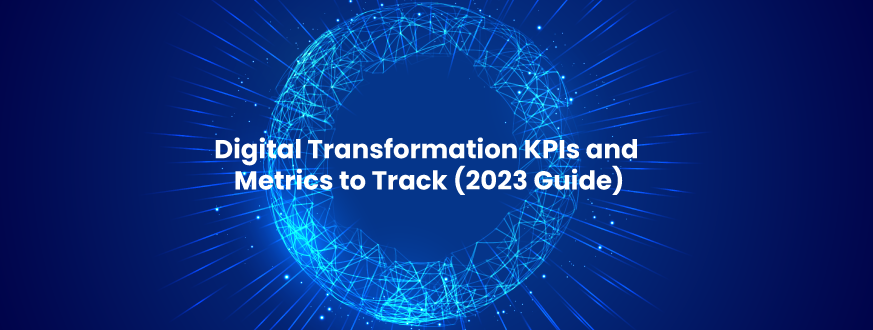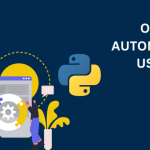So, you have successfully digitally transform your organization? Congrats!
Are you now planning to sit back and relax? Well, you shouldn’t. We wish digital transformation could replace legacy systems and update the outdated OS. It’s more than this. It’s an ongoing process demanding continuous attention on aspects like app performance, return experienced after digital transformation, updates required, and so on.
You can figure out all these things by keeping track of a few digital transformation KPIs and metrics. As there are tons of KPIs to track, you might find it hard to figure out which KPIs are worth your attention and which are not. Well, don’t be so confused now, as this blog talks about the best digital transformation KPIs and metrics that must be tracked in 2023 and many more years to come.
Why To Bothered About digital transformation KPIs and Metrics Tracking Before we talk about which digital transformation KPIs and metrics are consider-worthy, it’s essential to find out why you should be concerned about tracking them. Tracking certain digital transformation KPIs and metrics will help you find out the following:
Whether or not the digital transformation efforts are invested in the right direction?
Is the desired revenue or outcomes generated?
How effective is digital transformation?
Which all updates are required now or in the new future?
Awareness of all these things makes a business insightful enough to find out in which direction the digital transformation is going. If things are not going as per the plan, key personnel can take crucial decisions before it’s too late.
Which Digital Transformation KPIs and Digital Transformation Metrics To Track
While it’s essential that one must track business transformation KPIs and Digital Transformation Metrics that matter the most for an organization, the below-mentioned kpi for digital transformation and business transformation metrics are something that most businesses must track. We have categorized KPIs as per their operational domain for easy understanding.
Financial KPIs
Of course, money matters the most. One must ensure that the digital transformation done is bringing desired monetary outcomes. Here are a few KPIs and metrics that will help you find out this:
-
ROI
If you’ve recently done a digital transformation, ROI or Return on Investment is something everyone should track. These metrics will help you determine whether the technologies used were worth your money and decide on further investments.
For instance, if you’re experiencing low ROI, it’s a sign that you haven’t invested money in the right thing, and reassessment is highly required. High ROI signifies that your efforts and deployed technology are channeling properly and driving considerable results.
Even though ROI tracking is a must, we won’t suggest you go for it instantly. You must understand that it takes time for any technology or tool to bring projected returns. So, give enough time and then start tracking.
-
Revenue Per Employee RPE
This metric is calculated by dividing the total generating revenue by the total number of employees. If you’ve got a high RPE, it’s a sign that your employees are becoming well-versed with the technology used and can make the most of it.
-
Revenue from New Digital channels
You must take some new tools on board during your digital transformation journey. This KPI will help you find out whether investing in those tools was fruitful.
-
Employee KPIs
The direct impact of digital transformation would be on your employees. Hence, you need to ensure they are at peace and comfortable with new technology. These KPIs will help you understand that.
-
Employee productivity
The prime goal of digitally empowering is to enjoy more productivity by automating menial tasks and incorporating AI for help. By tracking employee productivity KPI, you can easily find out what impact AI and other technologies have managed to make in employee productivity.
-
Employee Absenteeism and Turnover Rate
Use this metric to determine whether your employees are getting used to the new technologies or finding an excuse to escape them.
If you find employee absenteeism high soon after digital transformation, it’s a sign that your employees do not like the makeover.
Customer KPIs
Your customers are who will bring revenue for you. So, it would help if you found out whether your customers like your digital transformation efforts or not. Here are a few key KPIs to understand this.
-
CSAT or Customer Satisfaction Score
The KPI will help you find out how satisfied your customers are with a new product or service. You must measure it pre and post-digital transformation; then, only you will be able to determine how the new technologies are impacting or redefining customer satisfaction. If it increases after digital transformation, then it’s confirmed that your efforts paid off well.
-
Net Promoter Score or NPS
This metric helps you determine the likelihood of a loyal customer’s product/service recommendation. This also should be measured before and after the digital transformation to determine if digital transformation can impress the customers.
Technology & Innovation KPIs
As digital transformation is all about technology and innovation, you must figure out how deeply the technology penetration is for your organization. This is possible with the help of the below-mentioned KPIs.
-
System Integration
Well-integrated systems are the core of digital transformation. Track this metric to find out how integrated your organization has become after digitization.
-
Cloud AdoptionRatio
Cloud adoption is often the center of digital transformation. Hence, this KPI will help you find out how many employees are using cloud tools and how deep the penetration of this technology is.
-
Software AdoptionPer Employee
With the help of this metric, it’s easy to find out how many employees are using modern applications and how many licenses are required. Tracking this KPI will help an organization predict future technology requirements as well.
-
Organizational Change Metrics
As digital transformation’s direct impact will be on an organization and the way it operates, it’s important to track some organizational change metrics to find out how fruitful the digital transformation has become on this front.
-
Data-Driven Decision-Making
This metric will help you find out what percentage of the latest business decisions are taken up using new tools and technologies.
-
Departmental Contribution
Digital transformation often takes place at a large scale covering leading operational aspects like HR, IT, finance, marketing, and sales. By tracking departmental contribution metrics, you’re able to find out which department is making the most use of new technologies and tools.
Keep Track of Everything
Completing digital transformation isn’t enough. One has to ensure that its adoption and implementation bring desired results. For this, you need to keep track of certain KPIs and metrics like ROI, NPS, digital adoption, employee satisfaction ratio, and many more that we discussed exhaustively in this post.
Keep track of these metrics and make sure that your digital adoption is a success. One more way to bring success to your digital adoption efforts is by hiring skilled DXSPs like C-Metric. With an in-depth understanding of the latest digital transformation means and the ability to delve deeper into details, C-Metric has achieved great success in every digital transformation project. Book a consultation to find out what more you can get.















Get in Touch